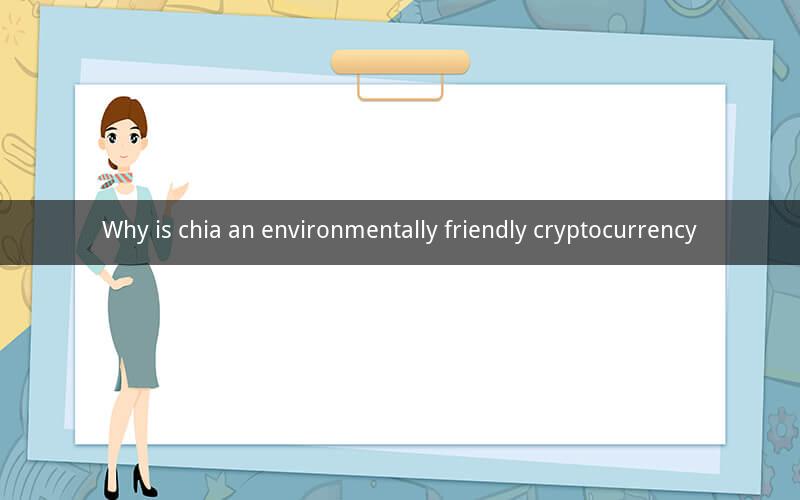
Table of Contents
1. Introduction to Chia (XCH)
2. The Environmental Impact of Traditional Cryptocurrencies
3. The Chia Network's Unique Proof of Space and Time (PoST) Algorithm
4. How Chia Mining Reduces Energy Consumption
5. The Role of Chia's Energy Efficiency in Environmental Sustainability
6. Comparing Chia with Other Energy-Efficient Cryptocurrencies
7. Challenges and Concerns Surrounding Chia's Environmental Impact
8. The Future of Chia as an Environmentally Friendly Cryptocurrency
---
1. Introduction to Chia (XCH)
Chia (XCH) is a cryptocurrency that has gained significant attention for its potential to address the environmental concerns associated with traditional cryptocurrencies like Bitcoin. Launched in May 2021, Chia aims to offer a more sustainable alternative by using a unique consensus mechanism known as Proof of Space and Time (PoST).
2. The Environmental Impact of Traditional Cryptocurrencies
Traditional cryptocurrencies, such as Bitcoin, rely on a consensus mechanism known as Proof of Work (PoW), which requires a substantial amount of computational power. This power consumption has raised concerns about the environmental impact of mining these cryptocurrencies, with Bitcoin's mining process being particularly energy-intensive.
3. The Chia Network's Unique Proof of Space and Time (PoST) Algorithm
Chia's PoST algorithm is a significant departure from traditional PoW systems. Instead of relying on computational power, PoST utilizes storage space. Users must reserve a certain amount of storage on their hard drives to participate in the network, which serves as collateral for their mining efforts. This method reduces the need for large-scale mining farms and their associated energy consumption.
4. How Chia Mining Reduces Energy Consumption
By requiring less computational power and focusing on storage, Chia mining consumes significantly less energy compared to traditional PoW mining. This reduction in energy consumption is crucial for addressing the environmental concerns associated with cryptocurrency mining.
5. The Role of Chia's Energy Efficiency in Environmental Sustainability
Chia's energy efficiency plays a crucial role in environmental sustainability. By minimizing energy consumption, Chia helps to reduce the carbon footprint associated with cryptocurrency mining. This is particularly important as the global community increasingly focuses on reducing greenhouse gas emissions and combating climate change.
6. Comparing Chia with Other Energy-Efficient Cryptocurrencies
While Chia is known for its energy efficiency, it's essential to compare it with other cryptocurrencies that also aim to reduce environmental impact. For instance, Ethereum has announced plans to transition from PoW to PoS (Proof of Stake), which is generally more energy-efficient than PoW. However, Chia's focus on storage space as a mining requirement sets it apart from other PoS cryptocurrencies.
7. Challenges and Concerns Surrounding Chia's Environmental Impact
Despite its potential benefits, Chia's environmental impact is not without its challenges and concerns. One concern is the amount of storage space required for mining, which could lead to increased demand for hard drives and potentially contribute to electronic waste. Additionally, the energy used to power data centers and other infrastructure needed to support the Chia network remains a point of concern.
8. The Future of Chia as an Environmentally Friendly Cryptocurrency
The future of Chia as an environmentally friendly cryptocurrency is uncertain but promising. As more users and organizations adopt the Chia network, the potential for widespread environmental benefits increases. However, ongoing research and development are essential to address the challenges and concerns surrounding Chia's environmental impact.
---
Questions and Answers
1. Q: How does Chia's PoST algorithm differ from traditional PoW?
A: Chia's PoST algorithm uses storage space as collateral, requiring less computational power and resulting in reduced energy consumption compared to PoW.
2. Q: What is the environmental impact of Chia mining?
A: Chia mining consumes significantly less energy than traditional PoW mining, making it a more environmentally friendly option.
3. Q: How does Chia address the issue of electronic waste?
A: Chia aims to address electronic waste by promoting the use of existing hard drives for mining, rather than relying on new, specialized hardware.
4. Q: What is the potential for Chia to reduce greenhouse gas emissions?
A: By reducing the energy consumption associated with cryptocurrency mining, Chia has the potential to contribute to a decrease in greenhouse gas emissions.
5. Q: How does Chia's storage requirement affect the hard drive market?
A: Chia's storage requirement may increase demand for hard drives, but it also promotes the use of existing storage solutions, potentially reducing the need for new hardware.
6. Q: What are the challenges faced by Chia in terms of scalability?
A: Chia's scalability challenges include ensuring the network can handle a growing number of participants without sacrificing its environmental benefits.
7. Q: How does Chia compare to other PoS cryptocurrencies in terms of energy efficiency?
A: Chia stands out for its unique approach of using storage space for mining, which generally results in lower energy consumption compared to other PoS cryptocurrencies.
8. Q: What role does community adoption play in Chia's success?
A: Community adoption is crucial for Chia's success, as it contributes to network security, adoption rates, and the overall sustainability of the network.
9. Q: How can Chia continue to innovate to address environmental concerns?
A: Chia can continue to innovate by exploring alternative consensus mechanisms, improving its network efficiency, and advocating for the use of renewable energy sources for mining activities.
10. Q: What is the long-term outlook for Chia as a sustainable cryptocurrency?
A: The long-term outlook for Chia as a sustainable cryptocurrency is positive, provided the network continues to innovate, address challenges, and gain widespread adoption.